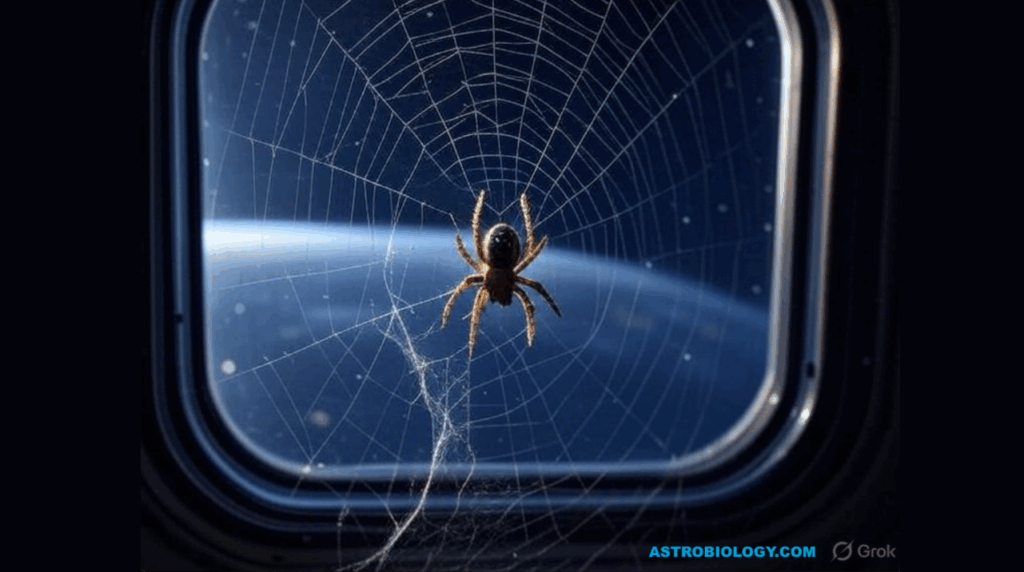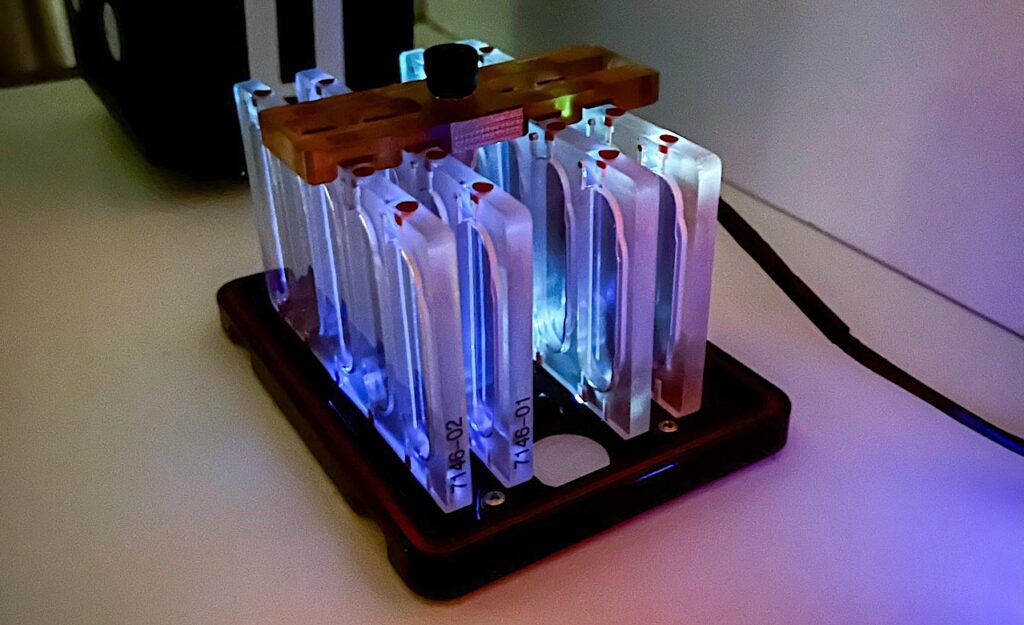NASA Spaceline Current Awareness List #1,164 29 August 2025 (Space Life Science Research Results)

NASA Spaceline Current Awareness – Grok via Astrobiology.com
The abstract in PubMed or at the publisher’s site is linked when available and will open in a new window.
Papers deriving from NASA support:
- McGregor HR, Hupfeld KE, Pasternak O, Beltran NE, De Dios YE, Bloomberg JJ, Wood SJ, Riascos RF, Reuter-Lorenz PA, Seidler RD.Crewmember demographic factors and their association with brain and ocular changes following spaceflight.npj Microgravity. 2025 Aug 28;11:59.PI: R.D. SeidlerNote: ISS results. This article may be obtained online without charge.
Journal Impact Factor: 5.1
Funding: “This study was supported by NASA grant #NNX11AR02G awarded to RDS, SJW, PARL, and JJB. HRM was supported by an NSERC postdoctoral fellowship, a Translational Research Institute for Space Health Postdoctoral Fellowship, and a NASA Human Research Program augmentation grant. KEH was supported by National Institute on Aging fellowships F99AG068440 and K00AG068440.” - Friedman MA, Zeineddine Y, Tuyambaze O, Elhawabri W, Al Shammary A, Stodieck L, Ferguson VL, Donahue H.Simulated microgravity accurately models long-duration spaceflight effects on bone and skeletal muscle in skeletally immature mice.Bone Rep. 2025 Sep;26:101871.PI: M.A. FriedmanNote: Hindlimb unloading study.
Journal Impact Factor: 2.6
Funding: “This work is supported by the Translational Research Institute for Space Health Postdoctoral Fellowship (NASA Cooperative Agreement NNX16AO69A), Center for the Advancement of Science in Space User Agreement UA-2019-888, and National Institutes of Health 3UM1TR004360-02S2.” - Lonner TL, Austin CR, Blake JS, Gupta P, Katz JM, Gopinath AR, Clark TK.Impact of sickness induced by centrifugation on tilt perception.Front Neurol. 2025 Aug 12;16:1628938.PI: T.K. ClarkNote: This article is part of Research Topic “Impact of Vestibular Dysfunction Studies on Space Flight Health Challenges” (https://genelab.nasa.gov). The Research Topic also includes articles from previous Current Awareness Lists #1,075 https://doi.org/10.3389/fneur.2023.1284029 and #1,139 https://doi.org/10.3389/fneur.2025.1556553. This article may be obtained online without charge.
Journal Impact Factor: 2.8
Funding: “This work was supported by the National Aeronautics and Space Administration Human Research Program under Grant No. 80NSSC23K0449.” - Hughes AM, Jenkins BE, Bauer LV, Kiss JZ.Performance and accuracy of the automated measurement software: Simple Online Automated Plant Phenomics (SOAPP).Gravit Space Res. 2025 Aug 7;13(1):51-64.PI: J.Z. KissNote: This article may be obtained online without charge.
Journal Impact Factor: 2.0
Funding: PI reports past NASA funding. - Johns S, Wiegman E, Bakshi A, Gilroy S.The cyclic nucleotide-gated channels CNGC2 and CNGC4 support systemic wound responses in Arabidopsis thaliana.Front Plant Sci. 2025 Aug 21;16:1545065.PI: S. GilroyNote: This article may be obtained online without charge.
Journal Impact Factor: 4.8
Funding: “The authors are grateful for funding for this work from NSF MCB2016177, NASA 80NSSC21K0577 and 80NSSC19K0126, and the Wisconsin Space Grant Consortium.” - Evans MA, Walsh K.Clonal hematopoiesis in cancer and cardiovascular disease: JACC: CardioOncology state-of-the-art review.JACC: CardioOncology. 2025 Aug;7(5):470-95.PI: K. WalshNote: This article may be obtained online without charge.
Journal Impact Factor: 12.8
Funding: “These studies were supported by National Institutes of Health grants AG073249 and AG086508, Department of Defense grant CA210887, and National Aeronautics and Space Administration grant 80NSSC21K0549 to Dr Walsh.” - Walsh RFL, Smith LT, Bisgay A, Stephenson AR, Goel N, Alloy LB.Sleep duration as a mediator of the association between caffeine intake and mood symptoms: An intensive longitudinal study of young adults with and without bipolar spectrum disorders.Chronobiology International. 2025 Aug 18;1-11. Online ahead of print.PI: N. GoelJournal Impact Factor: 1.7
Funding: “This study was supported in part by the National Science Foundation’s Graduate Research Fellowship to Rachel Walsh and by National Institute of Mental Health R01 grants [MH077908, MH102310, and MH126911] to Lauren B. Alloy. Namni Goel was supported in part by National Aeronautics and Space Administration (NASA) grants [NNX14AN49G] and [80NSSC20K0243] and National Institutes of Health grant [R01DK117488].” - Bouvet P, Bevilacqua C, Ambekar Y, Antonacci G, Au J, Caponi S, Chagnon-Lessard S, Czarske J, Dehoux T, Fioretto D, Fu Y, Guck J, Hamann T, Heinemann D, Jähnke T, Jean-Ruel H, Kabakova I, Koski K, Koukourakis N, Krause D, La Cavera S, Landes T, Li J, Mahmodi H, Margueritat J, Mattarelli M, Monaghan M, Overby DR, Perez-Cota F, Pontecorvo E, Prevedel R, Ruocco G, Sandercock J, Scarcelli G, Scarponi F, Testi C, Török P, Vovard L, Weninger WJ, Yakovlev V, Yun S-H, Zhang J, Palombo F, Bilenca A, Elsayad K.Consensus statement on Brillouin light scattering microscopy of biological materials.Nat Photon. 2025 Jul 3;19(7):681-91.Note: This article may be obtained online without charge.
Journal Impact Factor: 32.9
Funding: “…support from NASA, BARDA, the NIH and USFDA under contract/agreement no. 80ARC023CA002.”
Other papers of interest:
- Batool S, Jaswal T, Burles F, Iaria G.Hippocampal volumetric changes in astronauts following a mission in the International Space Station.NeuroSci. 2025 Jul 25;6(3):70.Note: ISS results. This article may be obtained online without charge.
- Pearl S, Kumar H, Vijayakumar S, Basu S, Ramaiah S, Anbarasu A.The evolution of superbugs in space: A genomic perspective on pathogens in the International Space Station environment.J Genet Eng Biotechnol. 2025 Sep;23(3):100536.
- Haozuo F, Xiangyang L, Yongkang T, Panfeng B, Mingjun D, Liangchang Z, Qiang B.[Research progress on the control and utilization of microorganisms in space animal culture.]Space Med Med Eng. 2025;(3):278-82. Chinese.Note: From the abstract: “The control and utilization of microorganisms in space animal culture is a key issue supporting research in space life science and extraterrestrial survival security. This paper systematically sorts out the sources, transmission routes, and potential threats of microorganisms in space animal culture.”
- Gao BX, Wang C, Jiang RX, Tian WM.[Space magnetic environment and circadian rhythm.]Sheng Li Xue Bao. 2025 Aug 25;77(4):721-30. Review. Chinese.Note: This article may be obtained online without charge.
- Mampre D, Stabenau K, Thurmond K, Petersen E.Spaceflight respiratory system from a nursing perspective.Crit Care Nurs Clin North Am. 2025 Sep;37(3):433-46.
- Xuan Y-Y, Li L, Wu Y, Wei Z-L, Zhang M, Liu M-N, Shen D-S, Gao Y-H, Xian CJ, Ma H-P, Chen K-M.Pinoresinol diglucoside alleviates hindlimb unloading-induced bone loss in mice.Life Sci Space Res. 2025 Aug 28. Online ahead of print.
- Yanhong L., Xiqing S.[Research progress on the effects of vestibular stimulation on cognitive ability.]Space Med Med Eng 2025;(3):274-7. Chinese.
- Rongxi PU, Fan BO, Siyuan H, Zhong Y.[Dimethoprim-sulfamethoxazole is metabolized to become a factor in cell proliferation and differentiation.]Space Med Med Eng 2025;(3): 214-9. Chinese.
- Li J, Ma D, Zhang C, Zheng X, Hao R, Zuo B, Xiao F, Li Y, Liu Y, Duan Z, Xiong Y, Fan OR, Zhu W, Dai L, Zhang B, Sun YE, Zhang X.Targeting miR-337 mitigates disuse-induced bone loss.Cell Discov. 2025 Aug 26;11(1):71.Note: This article may be obtained online without charge.
- Smowton A, Uthayasooriyan A, Kamran E, Terraciano S, Bhavsar P, Russomano T.Determining the best technique: Methods, challenges, and innovations of performing microgravity CPR.Acta Astronaut. 2025 Aug 20. Online ahead of print.
- Śniadek P, Krakos A, Graja A, Kawa B, Walczak R, Dziuban J.Autonomous, miniature research station (lab-payload) for the nanosatellite biological mission: LabSat.Sci Rep. 2025 Aug 22;15:30898.Note: This article may be obtained online without charge.
- Tripoli F, Ridolfi L, Scarsoglio S.Short-term response of cerebrovascular and ocular hemodynamics from micro- to hyper-gravity: A multiscale mathematical analysis.Acta Astronaut. 2025 Dec;237:159-73.Note: From the abstract: “In this study, we aim to shed light on cerebro-ocular hemodynamics during short-term exposure to altered gravitational acceleration (from 0g to 3g), by employing a multiscale 0D-1D model of the cardiovascular system.”
- Zenobi E, Gramigna G, Scatena E, Panizza L, Achille C, Pecci R, Convertino A, Del Gaudio C, Lisi A, Ledda M.Three-dimensional-printed biomimetic scaffolds for investigating osteoblast-like cell interactions in simulated microgravity: An in vitro platform for bone tissue engineering research.J Funct Biomater. 2025 Jul 24;16(8):271.Note: This article is part of Special Issue “Functional Biomaterial for Bone Regeneration” (https://www.mdpi.com/journal/jfb/special_issues/22LJI7A58B) and may be obtained online without charge.
- Yaghoubi M, Adib N, Monfared AR, Tondashti SA, Akhavan S.Human stress classification using cardiovascular and respiratory data based on machine learning techniques.J Med Signals Sens. 2025 Aug;15:24.Note: This article may be obtained online without charge.
astrobiology, space biology, microgravity, space medicine, space station,








